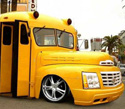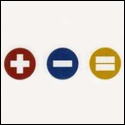|
Very cool, h_double. I will be following your example and posting results soon. I'm versed in Processing on both the visual and Arduino sides, and have used OSC in ChucK and PD, so I imagine that I can come up with something this week. I've been SLOWLY reading Visualizing Data by Ben Fry(author of Processing), and this gives me a perfect bit of inspiration to jump back in and do something fun with it.
|
|
|
|

|
| # ? May 28, 2024 03:14 |
|
Thanks! I have that Ben Fry book "Visualizing Data", it looks really good but I've only barely cracked it. Matt Pearson's "Generative Art: A Practical Guide To Using Processing" has been my go-to reference, it's focused on the visual elements of Processing (really , the rest of the language is pretty much the definition of easy peasy if you've ever done a lick of Java or any other curly brace language). I recently discovered ChucK, it looks like a cool language for audio coding, a little friendlier looking than Supercollider or csound, though that's not saying much, and I wish there were better documentation for it. My buddy is an iOS synth developer getting into MS Surface development, right now he's prototyping stuff by writing a touchscreen controller in C# and writing the synth part in ChucK, using OSC to communicate between the two with not-entirely-lovely latency. I've also been trying to learn my way around Max4Live better, I picked up the book "Max/MSP/Jitter For Music" by V.J. Manzo and I've really been enjoying it so far. It's explicitly written for musicians (and educators) first and foremost, which makes a nice change of pace from the built-in Max/MSP documentation, which is excellent but very dry and dense. The Manzo book is very methodically step-by-step, it maybe feels a little too verbose and repetitive in places but it's easy to skim those parts. It has a lot of tips for shortcuts and best practices (things that aren't readily obvious from the main Max/MSP documentation), and at the end of chapter 3 I've already built a nice little MIDI chord-builder device complete with UI. There's a couple of small translations I've had to make to adapt the examples to Max4Live, but nothing a quick glance at the example M4L "toolbox" patches hasn't cleared up. Overall I like the book a lot, and it's something Max/MSP has needed for a while; it's a really powerful environment but sort of a daunting learning curve. I also found a new series of video tutorials for Max4Live, produced by Cycling '74, which look very helpful (and have the bonus of giving a sneak peek at the Live 9 UI). h_double fucked around with this message at 17:01 on Dec 11, 2012 |
|
|
|
h_double posted:There are a bunch of reasons I don't like MIDI for inter-app communication. MIDI is mostly limited to integer values in a range of 0-127, while OSC uses high-precision floating point numbers. "virtual midi cables" are built into coreaudio and take little to no processor overhead, definitely no more than using your liveOSC driver. I agree that OSC is more up to date and offers a lot of advantages over MIDI, but MIDI persists in everything for a reason. For liveAPI access I just use max for live, I understand your alternative is cheaper/free but I'd argue that max for live has it's own advantages (and also supports osc). Either way both are totally valid ways to do what you're proposing.
|
|
|
|
MIDI routing via CoreAudio is nice, but there's no native equivalent in Windows. MIDI is like COBOL, it has persisted mostly because it was the only game in town from the early 80s through the late 90s. It's slow (roughly half the speed of a 56k modem), serial (has trouble staying in sync if you transfer more than a couple of things simultaneously), limited to 7 bit ints, gets stuck notes, can't really do alternative tunings, can't do per-note pitch bend, can't exchange audio streams, etc. I mean you CAN shoehorn some of that stuff in, but it's ugly, and I'd rather spend my time looking to the future and designing breakdancing robots and controlling a performance with facial expressions. And yeah, Max4Live owns, but it's an extra layer of complexity and doesn't have nearly as big a user base as plain old Live.
|
|
|
|
h_double posted:MIDI routing via CoreAudio is nice, but there's no native equivalent in Windows. Live also freezes up in windows when you do simple things like unplug an audio or midi interface and/or plug in a new one. It certainly wont detect those new devices if it manages not to crash your system or your session. Just more reasons not to use windows, my 2009 macbook pro still outperforms most modern PC laptops I see when I'm working shows. The last show I worked I had to help a performer rig up an emergency iPod and fade in a track that he mimed performing while he restarted his PC based ableton rig because his midi controller became unresponsive. Every other performer that night was on a mac and had no problems, with sets twice as complicated as his. quote:MIDI is like COBOL, it has persisted mostly because it was the only game in town from the early 80s through the late 90s. It's slow (roughly half the speed of a 56k modem), serial (has trouble staying in sync if you transfer more than a couple of things simultaneously), limited to 7 bit ints, gets stuck notes, can't really do alternative tunings, can't do per-note pitch bend, can't exchange audio streams, etc. It's only slow if you're using a hardware MIDI device that isn't USB. The USB MIDI spec allows speeds up to 112,000. As for staying in Sync with multiple events, that only occurs if you're trying to chain and merge multiple MIDI devices with MIDI cables, or if you're using old MIDI hardware that was poorly designed. A modern MIDI setup (all devices connected to a USB hub, running MIDI over USB cables) doesn't have this issue, if all the hardware is properly designed. If someone with my limited technical expertise can build MIDI controllers and devices that listen to MIDI, and design a handler in assembly that doesn't trip up when properly formatted MIDI is sent per the agreed spec, then there's no excuse for a modern MIDI device to not follow these protocols. Stuck notes is just a symptom of a poorly designed MIDI device, either in transmission or reception. What you are describing are problems that only apply if you're using MIDI in the old mindset of 10 years ago, and only working within the parameters of older legacy hardware. Your proposal of syncing up with processing, which is essentially a Java/C environment, is just as simple a solution as asking someone to understand the MIDI spec, which may be part of the issue here. You CAN do per note pitch bending within the MIDI spec, and you CAN do alternative tunings. But the question is within what framework? Most likely it would require programming something, either in a visual environment like Max, or in a source code language like processing. Niether is inherently better than the other, it's all dependent on the user and both instances could involve a learning curve. quote:I mean you CAN shoehorn some of that stuff in, but it's ugly, and I'd rather spend my time looking to the future and designing breakdancing robots and controlling a performance with facial expressions. That video is cool, granted, but is the magic here that you're using OSC or that you were able to make a max patch that can analyze video input? In that video it's max and ableton that are communicating within the OS, there's no speed limitation so that's out, and MIDI can do up to 14 bit resolution with 16 channel pitch bends. So what makes OSC so special in this example? quote:And yeah, Max4Live owns, but it's an extra layer of complexity and doesn't have nearly as big a user base as plain old Live. Your own video example uses MAX/MSP. And when live 9 comes out M4L will come standard with Suite, so the user base is about to get much bigger. Having used both processing and M4L, I would say that both are an extra layer of complexity, and the MIDI integration with M4L is much smoother than adding another driver to bring OSC into the mix. Furthermore M4L has direct access to the API, at which point neither OSC nor MIDI are as robust.
|
|
|
|
I don't really disagree with anything you're saying, my point is that OSC is a much more modern and developer-friendly and extensible API than MIDI, and that I encourage experimental coders to consider OSC rather than using MIDI just because it's so widespread. I like Processing because it's one of the easiest and most straightforward languages for prototyping stuff, way more so than Java or C++. Also because it ties so neatly into Arduino hardware projects. My use of Live was mostly incidental because that's what I use personally, and it's popular. I might try making and writing up a project with Processing + OSC + ChucK or Supercollider because I like to promote free + open source tools when possible.
|
|
|
|
Processing is great, I agree. And so is open source (when I developed my MIDI lights I chose open source instead of filing for a patent). But that said, there are advantages to closed source and commercial software development, especially when you get into specialized applications like music, which is why there still isn't much available in the way of quality open source audio/music software.
|
|
|
|
Looks like beta signups are open again, just so you guys know.
|
|
|
|
Back of the Bus posted:Looks like beta signups are open again, just so you guys know. Awesome, thanks for the heads-up.
|
|
|
|
I'm having some latency issues with routing MIDI from a Roland V Drums TD-11 into an Akai EIE Pro Interface (which is supposed to be zero-latency input) into Ableton Live. We tried adjusting sample rates and buffer but there still seems to be a very slight lag that might make live play impossible. I'm sure this has been asked a thousand times, but does anyone have any specific experience with latency using Roland V Drums? edit: Does having any other programs running that route to an audio output have anything to do with latency? For example, iTunes? I close those programs/browser windows just in case. I feel as if it helps my processor (2.5Ghz Intel Core 2 Duo) Tostito fucked around with this message at 05:41 on Dec 18, 2012 |
|
|
|
Tostito posted:I'm having some latency issues with routing MIDI from a Roland V Drums TD-11 into an Akai EIE Pro Interface (which is supposed to be zero-latency input) into Ableton Live. We tried adjusting sample rates and buffer but there still seems to be a very slight lag that might make live play impossible. Based on my own experience with my Virus Desktop and the many PDC threads on the Ableton forums, Live doesn't seem to be the best DAW for live play. There's probably something you can figure out with delay compensation that would address your current issue, but someone else will have to chime in on that. (I just switched back to Cubase when I started having these and other issues with Live... I never feel noticeable lag in Cubase.) Beyond adjusting your buffer settings, tons of things contribute to your round-trip latency (CPU, chipset, drivers, plugins used, bus type- PCI/PCIe/FireWire/USB, etc) but your interface's bus type and your PC's raw power are the biggest factors. Shutting down apps may improve reliability (how hard you can push your system before audio breaks down) but not latency.
|
|
|
|
I have a question I hope you can help me with. I've got Ableton Live and a Focusrite Scarlett 2i2. The Scarlett doesn't have a MIDI in btw. I want to learn how to play the drums, but in a way that won't disturb the neighbours. I also wanna get a digital kit so that I can easily record drums in Ableton. I was thinking about this kit: http://www.roland.com/products/en/HD-3/ But there's only a MIDI out (that's relevant for recording, as far as I can see). Does this mean that I'm hosed, and 1) need to get a different kit, or 2) get something to replace the Scarlett 2i2? How to people usually record digital drums? Via USB directly into a computer, or via MIDI through some sort of sound card?
|
|
|
|
Xabi posted:I have a question I hope you can help me with. I've got Ableton Live and a Focusrite Scarlett 2i2. The Scarlett doesn't have a MIDI in btw. I think you'll need a midi-by-usb kit like this: http://www.alesis.com/usbprodrumkit
|
|
|
|
Xabi you probably have a few options: - Upgrade your interface to one with built-in MIDI (like the Scarlett 8i6). - Get a separate USB-to-MIDI interface. Most USB (keyboard or pad) controllers have MIDI connectors you could use, or you could look into a dedicated USB-to-MIDI box. There are also cheap ($5-10) USB-to-MIDI convertor cables but I don't know if they are any good. - A drum kit with built-in USB output is an option, though if you like the feel and layout some other kit, it shouldn't be a deciding factor.
|
|
|
|
Both of you, thanks! I'm not sure if that's the drum kit I want, but after reading some reviews and trying it for a couple of minutes, it seemed like a good choice. I'm a big n00b though, so it might suck. What really sold it for me, was that it's apparently very neighbour-friendly, which is important for me because of where I live. It seems that upgrading my Scarlett might be the best choice. I'm not just a n00b on the drums, but also when it comes to recording. So for all I know, I might be looking at this from a wrong direction. What do people usually do with digital drums and a digitial piano? Record directly via USB into a computer, via MIDI and something like the Scarlett 8i6, or something completely different? Because I wanna get a digital piano in the future as well, without having to change the entire setup.
|
|
|
|
Guitar Center has Push up for pre-order with a release date of 2/10/13, and a $100 off coupon right now which knocks it down to $499. I went ahead and ordered it, but the copy of Live 9 Intro it comes with seems very limited. Is it worth the extra money to go with the Suite over standard? Are the boxed versions worth the extra money over the download versions?
|
|
|
|
Plavski posted:I picked up the LPC-Live after all and man is it amazing. Not only does it give you full control over absolutely everything, you've also got a step sequencer, a drum machine and an awesome note/scale playing thing thatis just incredibly fun for tapping out melodies. Set it to any key you want, then pick from the massive list of modes and away you go. With your song set in a key, you can just freestyle write melodies on the fly, then change tabs to go edit the 303 you've got playing on one track, then move back and start chopping up and sequencing loops all from the pad itself. So far, I looked at the first video the creator of LPC-Live put together on the product's web page, and my first reaction was OH HOLY CRAP HOW DOES ANYONE KEEP ANY OF THIS IN THEIR HEAD? It seems ridiculously full of modal interactions with very little in the way of telling you which mode you're in at the time (mostly a constraint of the Launchpad just being a simple grid). I'll admit that I'm only really familiar with the basic Launchpad layout that I get when I connect it to Live, but then, all the labeled buttons and lights assume that to be the case, so it's fairly easy to find my footing again if I lose track of where I am with the controller. Outside of that, I do also use Lauflicht, which turns the Launchpad into a step sequencer controller for Renoise, but it seems pretty straightforward compared to LPC-Live. All that being said, LPC-Live is cheap enough to "not not own", but I wonder if I'd actually use it much. I've fooled around with MPCs in the past, but have never used one as my dedicated composition instrument/controller; if that's my background, do you think I'm likely to get much out of LPC-Live, such that it's worth ramping up the learning curve? Is it not as obscure of an interface as it first appears, and are all of those modes actually "natural" once you learn them?
|
|
|
|
You pick it up really quickly and I was quite surprised how easily I took to it. A lot of it is discovery, but it's actually quite intuitive and I found myself able to quickly jump around and do stuff like a pro after only an hours play. He's also updated it for Live 9 now.
|
|
|
|
Plavski posted:You pick it up really quickly and I was quite surprised how easily I took to it. A lot of it is discovery, but it's actually quite intuitive and I found myself able to quickly jump around and do stuff like a pro after only an hours play. A few months back I was looking at this dude's (https://www.youtube.com/watch?v=GU_4i8FFkjo) preset for a Maschine based workflow, which seemed to sit right with me, in that he's explicitly going for minimalism over maximalism WRT functionality available in the preset, and a focus on making the workflow smooth for sketching out an idea as quick as possible (still the part I find the most cumbersome when working with Live, to be honest). Maybe I'll try to compare these with one another once I get situated with LPC-Live.
|
|
|
|
My Behringer BCR2000 showed up today, but I'm at work for a while longer before I can go home and play with it. Siets, my Ableton Live setup is almost a proper superset of yours now; Live, Launchpad, Fast Track Pro, but the BCR2000 instead of your Evolution UC-33 (I also have Maschine(s), but haven't yet worked them in to Live). I imagine I'll be using my BCR2000 similar to how you use your UC-33. Did you find any specific setups for your knobs to be absolutely clutch? Care to share notes/swap setup details?
|
|
|
|
I'm trying to set up an effect chain to do something relatively simple but I simply cannot figure out how to achieve it. I'm playing a guitar into Ableton. At the end of each bar I'm turning a Guitar Rig tape echo effect on, letting it feed back, and then turning it off, creating a swelling effect at the end of each bar. So far, simple: Guitar -> Guitar Rig tape echo delay. (with automations to turn it on and off at the end of each bar). But I want to do something else on top of this. I want to add a small second delay to the first delay, so that when I turn the first delay off, you still get a little delay audio trailing off it - not such a sudden stop. Guitar -> Guitar Rig tape echo delay 1 -> Guitar Rig tape echo delay 2. The problem here is I want Delay 2 to only hear audio from Delay 1. I don't want it to be able to hear the guitar too. I just want it to take whatever audio Delay 1 spits out, and then Delay 1 isn't doing anything, Delay 2 doesn't do anything. I feel like this should be really simple to do this without automation, but I can't figure it out. Help.
|
|
|
|
Why not just use a Split tool in Guitar Rig to fade the delay effect in and out?
|
|
|
|
I can't see how the split tool would help anything. It'd still be taking the original guitar signal in with it.
|
|
|
|
How about if the second delay is on a send channel that also contains a gate that's sidechained to the dry guitar signal? Set it up so the gate would only let signal through when the guitar isn't playing.
|
|
|
|
The guitar is playing 100% of the time. I need to work out a way for Delay 2 to only listen to Delay 1, and not the guitar at the bottom of the signal. Right now, when I turn Delay 1 off, Delay 2 gets a signal straight from the guitar. I need it not to do that. I need it to hear noooothing.
|
|
|
|
I haven't used Guitar Rig so maybe this isn't possible. Can you put Delay 1 on a send and then put Delay 2 on a track that gets its input from that send? I think that'll do what you want as long as Delay 1 doesn't output the dry guitar signal.
|
|
|
|
Popcorn posted:I can't see how the split tool would help anything. It'd still be taking the original guitar signal in with it. Use the split tool: Chain 1: Guitar --> Delay 1 --> D1 output of 50/50 wet/dry mix (or whatever it is) Chain 2: Guitar --> Delay 1 --> D1 output of 100% wet mix (no guitar) --> Delay 2
|
|
|
|
Ableton 9 Beta sign-up is open again, at least for now.
|
|
|
|
deathmerc posted:Ableton 9 Beta sign-up is open again, at least for now. Thank you. I'm loving it so far.
|
|
|
|
phractured posted:Thank you. I'm loving it so far. "Unfortunately, you are not eligible for the Live 9 Beta program." curses.
|
|
|
|
Oh, seems like I was already in the beta. I didn't even notice when that had happened  I really like the improvements on old features like the enhanced UIs on some of the effects and much better automation/envelope editing (not only because of the curves but a better workflow overall with much less clicking involved). Audio to MIDI conversion also seems to work well enough for my needs.
|
|
|
|
What is the easiest way to save the settings for all the audio and midi tracks in a song to be used later for similar songs? I have 3 audio tracks, each with their own settings (Focusrite Scarlette and Guitar Rig) and 2 midi tracks (ezdrummer and DSK synthopia) that I would like to use for basically making an album.
|
|
|
|
Fiendish Dr. Wu posted:What is the easiest way to save the settings for all the audio and midi tracks in a song to be used later for similar songs? You can go to Options->Preferences->File Folder and hit "Save Current Set as Default" and then whenever you open Ableton or start a new file, it will have that setup.
|
|
|
|
Shovelbearer posted:You can go to Options->Preferences->File Folder and hit "Save Current Set as Default" and then whenever you open Ableton or start a new file, it will have that setup. Is there a way to have multiple sets? For example: one for metal, one for blues, etc
|
|
|
|
...
colonp fucked around with this message at 18:08 on Mar 8, 2014 |
|
|
|
colonp posted:Afaik you cannot have multiple "startersets" but you can just set it up how you like and save it like a regular track. Also one handy trick is that you can import one or more tracks easily by browsing to the song with live's browser and expanding the song like a folder.
|
|
|
|
With that in mind for what I want to do could set up a few live sets with nothing but the track settings and save them each as the genre or project type. Metal, blues, country, etc. And then import them using the browser thing. Sounds easy enough. What I was doing before was just opening the song that had the tracks set up and saving it as a new file. This should help.
|
|
|
|
I'm sure this is a really elementary question with an easy answer, but how do I create a rhythmic gate effect triggered solely by parameters that I set (as opposed to one that's triggered by another track). For example, I'd like to be able to set a rhythmic gate every quarter-note, have it hold for X milliseconds, and so on.
|
|
|
|
For anyone who hasn't seen it yet: Ableton Live 9 - The New Features and Creative Ways to Use Them - Tom Cosm https://www.youtube.com/watch?v=Q6pwSpEwH1M
|
|
|
|

|
| # ? May 28, 2024 03:14 |
|
Brock Velocity posted:I'm sure this is a really elementary question with an easy answer, but how do I create a rhythmic gate effect triggered solely by parameters that I set (as opposed to one that's triggered by another track). For example, I'd like to be able to set a rhythmic gate every quarter-note, have it hold for X milliseconds, and so on. You can trigger the gate with another track that's not audible in the main mix. That is, a track that has its output set to "sends only" can still be used as a sidechain input to a gate. Just take a simple bass synth with a fast attack and release, play the rhythm you want to use as a gate pattern, then sidechain that into the track you want gated. You could also put a looped 1-bar volume automation clip on the track and do it that way. h_double fucked around with this message at 01:11 on Jan 17, 2013 |
|
|

























